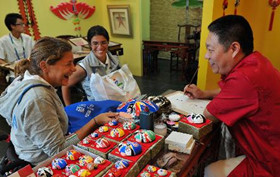- +86-13267351235
- info@globalstourtravels.com
As the old saying goes, "Each place has its own way of  supporting its own inhabitants." For China, an agricultural country backed by the agriculture and handcraft industry in the history, is nowadays permeated with traditional lifestyles originated and derived from the natural conditions in farming society. As an outcome of people's life and customs, an enormous variety of traditional handcrafts are anchored among the folk. Characterized by cultural features differing from other birthplaces of civilization, such practical, simple and warmhearted arts have always demonstrated China's national economy and people's livelihood from ancient to modern times. Speaking of court crafts serving rich and powerful ones, scholar-bureaucrat crafts highlighting the fun of literati and folk crafts spilling local flavor, all the intentions to invent and create have come from Chinese's daily needs in certain natural conditions. All of these crafts, acting as the important carrier of Chinese civilization, contain the wisdom of creation accumulated during production and life.
supporting its own inhabitants." For China, an agricultural country backed by the agriculture and handcraft industry in the history, is nowadays permeated with traditional lifestyles originated and derived from the natural conditions in farming society. As an outcome of people's life and customs, an enormous variety of traditional handcrafts are anchored among the folk. Characterized by cultural features differing from other birthplaces of civilization, such practical, simple and warmhearted arts have always demonstrated China's national economy and people's livelihood from ancient to modern times. Speaking of court crafts serving rich and powerful ones, scholar-bureaucrat crafts highlighting the fun of literati and folk crafts spilling local flavor, all the intentions to invent and create have come from Chinese's daily needs in certain natural conditions. All of these crafts, acting as the important carrier of Chinese civilization, contain the wisdom of creation accumulated during production and life.
Crafts depend on skills, as the weather relies on seasons, the earth on the weather, and the material on appearance. Traditional Chinese arts and crafts have won good reputations in the international community in the history of material culture. Since Zhang Qian's diplomatic mission to the West (?-114 BC) in the Han Dynasty and the gradual advent of the Silk Road, China's traditional arts and crafts have been continually exported to the Central Asia, the Western Asia, the Middle East, Europe and other regions across the world. Chinese craftsmen in the bygone ages often lived on their craftsmanship when civil war or foreign invasion broke out, and they inadvertently served as cultural popularizers. In addition, arts and crafts often have a close relation with China's traditional philosophy. Around the first century A.D., ideologists in ancient China used to describe or interpret their thoughts about national governance and people's life by resorting to crafts and craftsmanship as metaphors.
All this has much to do with China's unique geographical location and its long and continuous farming culture.
Mainland China has a long coastline, but its civilization was originated in the hinterland, i.e., the Central China, where the Xia, Shang and Western Zhou dynasties, the three earliest regimes in China, were established one after another. For ethnic groups inhabiting in plains and mountainous areas, farming is the most significant way for subsistence. It is the life and artistical style in this agricultural society that defined the characteristics of traditional Chinese handicrafts. Craftsmanship has been developed in people's life and production activities. Originally, all varieties of crafts were made for practical purpose, so they were practical, simple, user-friendly, and adaptive to agricultural progress. Even royal crafts and scholar crafts, the pinnacle of crafts, retained the practical and simple features. They have a natural decorative style, with landscape, animals and plants in a natural economy as the subjects of their patterns and ornaments. We hardly find some weird and ferocious elements in them. Instead, they present cheerful and optimistic spirit.
In China's traditional moral philosophy prevails the maxim "Excessive attention  to trivialities saps the will." What it denounces is "exquisite, but useless skills and products" and the overdevelopment of unpractical skills. Such thought unconsciously influences China's craft to develop towards functionalism in thousands of years and it causes manual skills to develop the most in the agricultural society without any waste of social resources. This also makes it some what conservative. When technology accumulation reaches a certain level, it will limit and delay promotion of social and scientific progresses.
to trivialities saps the will." What it denounces is "exquisite, but useless skills and products" and the overdevelopment of unpractical skills. Such thought unconsciously influences China's craft to develop towards functionalism in thousands of years and it causes manual skills to develop the most in the agricultural society without any waste of social resources. This also makes it some what conservative. When technology accumulation reaches a certain level, it will limit and delay promotion of social and scientific progresses.
Generally, however, China's traditional arts and crafts are laudable. They are rich cultural heritages left to us, containing people's creation and wisdom in life.
"Arts and crafts" are not common artificial articles. Especially for Chinese "arts and crafts," they are the live geographical specimens of the culturally unique Asia, and the "prototype" of China's unique life style, reflecting the relationship among land, human and production activity in an implicit way. They as gifts or goods are passed on or exchanged in history and life. It is exactly for this reason that "arts and crafts" are everlasting, and that they are inseparable from Chinese people's life.